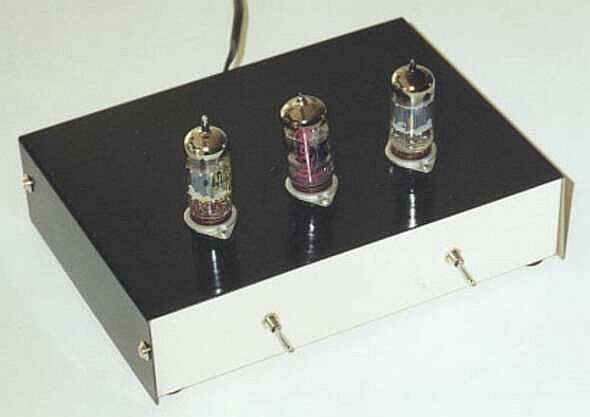A HIGH-PRECISION TUBE PHONO PREAMP
by Fred Nachbaur, Dogstar Music ©1998, 2001
2: DESIGN PHILOSOPHY
The design philosophy was to improve on "vintage" tube designs by incorporating refinements
normally only associated with solid-state gear. Prime among these is the use of differential input
stages, in which the inverting input is used strictly for feedback. Another is the use of direct
coupling between stages, a technique once quite common in oscilloscopes, but rare in audio gear.
The resulting circuits are thus closely related to the operational amplifier, and used in a similar
fashion.
In addition to the quasi-opamp idea, some other design concepts used in the project are:
- Use of readily available parts wherever possible. For this reason, tube types
12AX7A and 12AT7A were employed.
- Direct coupling was used in crucial parts of the circuitry. More about this later.
- Flexibility in use was a prime consideration. While this articles details the use of this circuit
design as a magnetic (RIAA) and ceramic phono pre-amplifier, there is virtually no limit to the number
of possible applications with suitable modification of the feedback networks.
A Word About Negative Feedback
It is perhaps an unfortunate accident of history that the term "negative feedback" was used to
describe the linearization technique of applying a portion of the output signal back to the input, in
opposite phase to the applied signal. It gives the impression to audiophiles with enough
knowledge to be dangerous that "negative" feedback must somehow be a "bad" thing. I've seen
diatribes against the evils of negative feedback, yet in the same breath such critics extol the
virtues of "ultra-linear output transformers." The joke is that such transformers (using screen-grid
taps on the primary) achieve this linearization by applying local negative feedback to the screen
grids!
Perhaps a better moniker for "negative feedback" would be "dynamic compensation" or something
on that order. Consider the following characteristics of well-designed negative feedback systems:
- A: Precise control over closed-loop gain and minimization of gain drift with component aging.
- B: Considerable reduction in distortion and noise introduced within a given gain block.
- C: Reduction of effective series output resistance.
- D: Precise control and stabilization of frequency characteristics. Extension of high-frequency
response where needed.
- E: Reduces or eliminates the need for careful component matching

The Completed, operational Standalone Preamp Prototype







